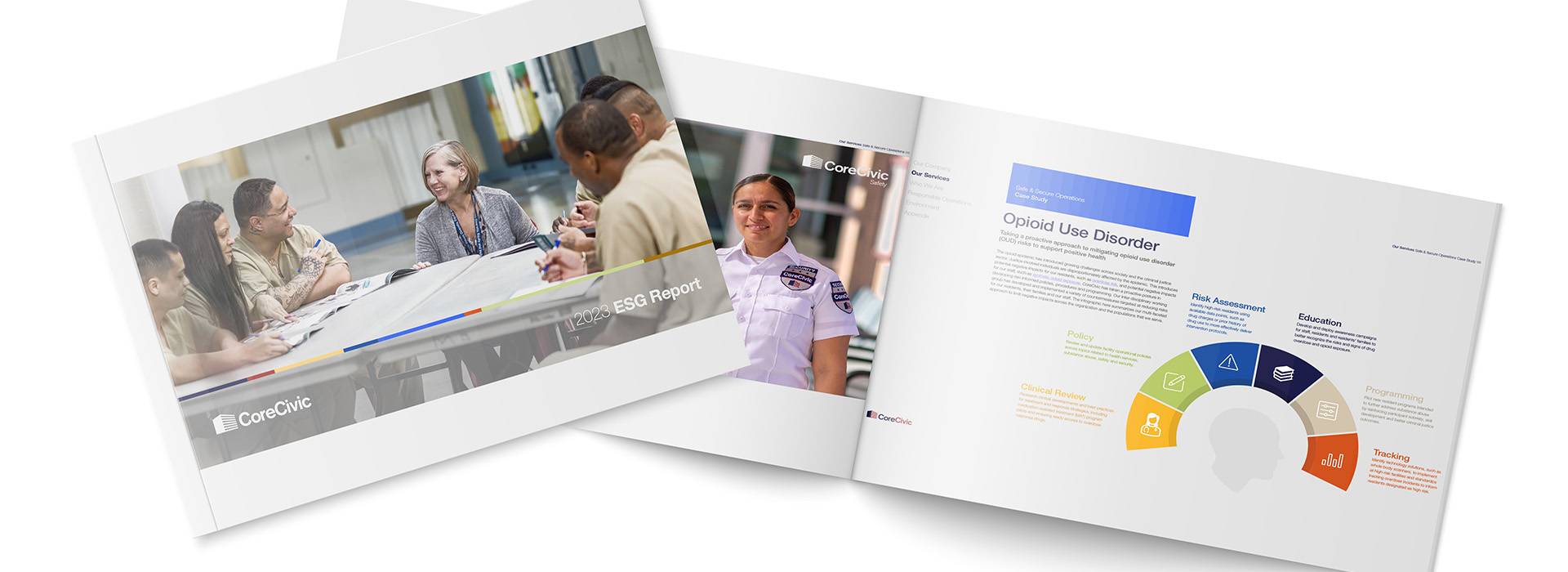As net zero deadlines draw closer, sustainability is top of mind for more organizations than ever — including those in the energy industry. Driven by corporate mandates and a fast-evolving regulatory environment, an increasing number of energy organizations are not only setting environmental, social and governance (ESG) targets but communicating them both internally and externally. Simply put, ESG communications have become the norm and not the exception; if your energy organization isn’t talking about sustainability, it should be.
(Before we get any further, a quick note on semantics: While “ESG” and “sustainability” are similar terms, ESG is more specific and measurable, while sustainability is typically seen as an umbrella term. Most of our clients include reporting for ESG goals within their sustainability reports, and we’ve taken that approach in this article. However, there are some cases in which a sustainability report will cover just that — environmental but not social or governance initiatives.)
ESG and sustainability communications encompass many tactics and strategies, yet few initiatives are more critical than the sustainability report. A recent McKinsey study found that 95% of Fortune 500 companies — a list that includes more than 60 energy organizations — issued these reports in 2022. Once the dust settles and 2023 reports are issued, that percentage will likely be even higher. Why? Because these reports allow your brand to tell the story of its ESG goals, progress, reporting and future plans in a format widely recognized by stakeholders.
Whether you’re creating your first sustainability report or need to improve upon the one you produced last year, this article is for you. Read on for useful best practices that will make your next sustainability report a success in the eyes of your stakeholders, employees, partners and the public.
Understanding Sustainability and ESG Communications
Before we get into best practices for your annual report, it’s helpful to get a deeper understanding of sustainability communications, its challenges and its impact on businesses, especially in the energy industry.

Why Sustainability and ESG Reporting Matter
ESG reporting can look different for every company. However, at a high-level, it can be described as the process through which companies track, document and publicly disclose their progress toward ESG goals. Unlike traditional financial reports, ESG reports — also called sustainability reports — focus on qualitative metrics related to environmental impact, social responsibility and corporate governance. From tracking waste production to monitoring community investment, these reports provide stakeholders with clear, valuable insights into a company's sustainability efforts.
In an energy landscape characterized by accelerated decarbonization efforts, increased stakeholder expectations and unparalleled public scrutiny of sustainability practices, effective ESG reporting is crucial for companies looking to proactively manage risks, meet evolving shareholder demands, comply with regulations and enhance performance. More than a voluntary practice, annual sustainability reports have become a critical component of corporate accountability, with customers, employees and investors alike seeking transparency and authenticity in business operations.
Beyond meeting the public's expectations and regulatory requirements, ESG reporting offers a range of benefits for energy companies.
- Brand Reputation: Through ESG reporting, companies showcase their commitment to safeguarding the environment, fostering strong communities and operating ethically. When told authentically, this story can enhance a brand’s image and help attract top talent.
- Accountability: Sustainability communications foster accountability internally and externally. Internally, it can align a workforce behind clearly-stated ESG goals. Externally, it can hold leaders accountable for their commitments.
- Trust: By transparently sharing ESG progress and avoiding greenwashing, organizations can strengthen stakeholder confidence while building trust with wider audiences.
- Capital: In a 2023 study, 85% of Chief Investment Officers identified ESG commitments as an important decision-making factor. To tell a strong story for investors, clearly link between sustainability initiatives and financial performance through data.
- Future Growth: As the energy transition progresses and energy security issues continue to shape the industrial landscape, sustainability initiatives can help foster future growth. If your investments include technologies or services that enhance sustainability efforts, include them in your report.
Sustainability reports can deliver tremendous value for growth-minded energy organizations. But as this reporting becomes essential, expectations have also increased. This is especially the case among investors, who expect a clear link between sustainability, strategy and financial performance. As McKinsey puts it, “Sustainability aspirations or metrics on a page, without context, are not sufficient to link initiatives to cash flow.”
This makes it all the more important to not only publish an annual report, but to put your best foot forward from the first to last page. Irrefutable data and strong storytelling are key.

8 Best Practices for Crafting an Effective Sustainability Report
While the benefits of sustainability reports are clear, creating these in-depth documents can be a daunting task. From data availability and standardization to aligning with corporate strategy, creating a compelling sustainability report requires careful planning and execution. Here are some tips to help you get started based on our decade of helping global energy organizations produce these critical documents.
Use Data to Determine Your Current PositionGather data to assess your current ESG performance. This data can come from numerous internal and external sources — internal financial reports, customer feedback and employee surveys, as well as external industry benchmarks, ESG ratings, third-party assessments and beyond. If you’re creating a new reporting framework, prioritize consistent, standardized data collection methods; these will enable accurate analyses for future reports.
Every business has unique dynamics that impact its ESG priorities. However, if you’re struggling to identify your current position, these ideas could help you get the ideas flowing.
ESG Communications Considerations for Operators
- Emissions data: Measure greenhouse gas emissions from exploration, drilling and production activities.
- Energy efficiency: Track energy consumption and efficiency measures at drilling sites and production facilities.
- Water management: Monitor water usage and wastewater treatment processes to minimize environmental impact.
- Health and safety metrics: Record incidents, accidents and near misses to ensure a safe working environment for employees and contractors.
- Technology enhancements: Consider the impact of technologies that prevent significant environmental issues by enabling remote accessibility, preventative maintenance and/or immediate responses to risks.
ESG Marketing Considerations for OEMs
- Product sustainability: Quantify the environmental impact of manufacturing processes and product lifecycle, including energy usage, material sourcing and end-of-life disposal.
- Supply chain sustainability: Assess suppliers' ESG practices, such as ethical sourcing, labor standards and environmental compliance.
- Innovation and R&D efforts: Highlight investments in sustainable technologies and product innovations that reduce environmental footprint and improve efficiency.
ESG Marketing Considerations for Service Providers
- Project sustainability: Evaluate the environmental and social impacts of construction projects, including land use, emissions and community engagement.
- Employee engagement: Measure employee satisfaction, diversity and inclusion initiatives and training programs focused on sustainability and ESG awareness.
- Community relations: Document community outreach programs, philanthropic efforts and partnerships aimed at supporting local communities and promoting sustainable development.
ESG Marketing Considerations for Office-Based Companies
- Office sustainability: Track energy consumption, waste generation and recycling efforts within office facilities that minimize environmental footprint.
- Telecommuting and remote work: Assess the impact of remote work policies on reducing emissions from employee commuting and office operations.
- Sustainable practices in software development: Highlight features and functionalities in software products that promote sustainability, such as energy-efficient algorithms or carbon footprint tracking tools.
By collecting and analyzing relevant data tailored to your company type, you can gain valuable insights into your current ESG performance — and determine which strategic ESG goals to prioritize in your annual report. Make sure to take note of any “wins” that you’ve already achieved, which should be highlighted in your report alongside the areas in which you need to accelerate progress.
Clearly Define and Prioritize Your ESG GoalsYour sustainability story is only as compelling as the goals you’re working to achieve. Once you have a comprehensive, data-driven picture of your current strengths and weaknesses, it’s time to identify and prioritize your ESG goals. These goals should be clear, actionable and data-driven. They should also align with both your reporting framework and lead to intentional, strategic decisions that can drive progress. Consider conducting an ESG materiality assessment if you lack a clear view of your strategic priorities.
To ensure that your goals lend themselves to measurable ESG progress, craft them to be:
- Comprehensive, covering all facets of ESG. While sustainability will likely be the highest priority within your report, social and governance issues should also be included within the scope of your metrics.
- Objective and objectively measurable. Connect your goals to numbers — i.e., amount of CO2 emissions avoided across your supply chain or gallons of water conserved in your processing facility — so that you can tell a data-driven story about your progress.
- Universal and relevant to your industry. Your metrics should be specific to your company. However, they must also be meaningful to stakeholders and others in your industry.
Once you’ve established your goals, prioritize them and determine what “annual” progress looks like. Some high-priority goals, such as achieving net zero by 2050, will require long-term, concerted efforts across your organization; for these goals, identify what progress needs to be achieved annually to keep you on target. Within your short-term priorities, think about which can reasonably be achieved in one year and what concrete actions will be required to do so. By understanding the efforts and realistic timelines required for each priority goal, you can ensure that every annual report will include meaningful progress — even if that progress is an incremental improvement rather than a fully-realized goal.
- Develop a Repeatable Framework
You’ve clearly outlined and prioritized your ESG goals. You’ve compiled data, identified your “wins” and understand what it will take to get your organization’s ESG initiatives from where they are today to where you want to go. Now, it’s time to turn this into a compelling — and repeatable — story.
We won’t get into all the ins and outs of sustainability report storytelling, as it’s highly strategic and can vary from one organization to the next. But no matter how you structure your report, prioritize repeatability. If you’re opening with a letter from your CEO, make sure to include one in future reports. If you structure the report into sections for environmental, social and governance, keep that consistent in next year’s document. And remember that any metrics included in your current report should ideally be revisited in future ones to help reinforce your company’s progress toward its priority goals.
As you’re developing your framework, don’t be afraid to include areas in which further progress is required. This allows you to build trust and avoid greenwashing, which can render your report irrelevant PR “fluff” at a time when sustainability has never been more critical to an energy organization’s success.
A consistent, repeatable framework allows readers to clearly understand your progress from one year to the next. But it also serves another practical purpose: making it easier to produce the copy and design of future reports, which can be based upon the templated approach you develop in Year One. (If you’ve created a sustainability report in the past and want to improve the approach, consider using an opening letter to communicate the enhancements you’ve made in the current document – framing them as part of your commitment to telling your ESG story as it evolves.)
- Consider an Opening Statement from an Executive
Engage leaders within your organization, such as C-level executives and board members, to provide opening statements in your annual report. Make sure to align their messages with the ESG goals, their progress and the data you are presenting. These statements not only add a layer of credibility and authority to your company's sustainability efforts, but serve as another platform for key leaders to communicate directly with stakeholders. Use your sustainability report’s opening statement to convey the company's vision, values, commitment to sustainability and key progress points in one succinct page. - Break Out Key Numbers and Statistics
Present key numbers and statistics clearly — and visually — in your annual report. This allows busy stakeholders to quickly grasp the most important aspects of your ESG performance.Highlighting achievements in areas such as carbon emissions reduction, diversity and inclusion initiatives, and community engagement efforts reinforces transparency and accountability. Consider visualizing critical data points with graphs and charts to enhance comprehension and ensure readers can easily identify trends and patterns in your sustainability efforts.
- Engage and Align Key Stakeholders Early in the Content Development Process
Like ESG goals themselves, your sustainability report is a strategic initiative that requires alignment among key internal stakeholders — many of which could be unfamiliar with the content development process for such a high-visibility document. For this reason, it’s critical to involve internal parties from the start.One simple, effective way to ensure alignment is to share a detailed outline of the report’s content prior to developing any copy or visuals. This establishes a shared understanding of objectives and expectations and eliminates surprises once it’s time to review first drafts. When it comes time to incorporate feedback, ensure you’ve received thoughts from all required stakeholders before doing so. This will save significant time and avoid a delayed annual report launch.
(We’re assuming that all key stakeholders have signed off on the organization’s official ESG goals, priorities and data reporting mechanisms well before content development begins. If this isn’t the case, then it’s too soon to begin developing your report’s content.)
- Consider Compliance Implications
Evaluate your annual report against regulatory compliance requirements. Whenever possible, ensure the information presented in the report fulfills mandatory ESG reporting obligations from relevant regulatory bodies. By establishing consistency between your sustainability report and compliance obligations, you can demonstrate your commitment to transparency and your understanding of the complex regulatory landscape. Addressing compliance considerations proactively throughout the ESG report development process can also help you identify — and proactively address — any gaps or discrepancies before publishing your report. - Don’t Forget the Human Element
Your sustainability report should be data-driven and concrete. However, that doesn’t mean that it should be devoid of the human element — especially given the impact of environmental, social and governance initiatives on your workforce and larger community.
To tell a story that resonates, consider including quotes or anecdotes from employees, suppliers and partners. These can be as simple as quotes about why these goals matter to them or a brief account of an ESG initiative in which the employee was involved. These elements are relatively quick to develop, yet they can go a long way toward helping employees — and stakeholders — feel more engaged with your organization’s sustainability story.
- Whether your energy organization is creating its first sustainability report or needs help enhancing this fundamental element of ESG communications, the right approach — and expertise — is key. Over the last decade, HexaGroup has executed strategic ESG reports for organizations across the energy landscape. That includes Schlumberger, with whom we collaborated to launch its first Global Stewardship Report. This 90-page report visually represented the company's HSE statistics, environmental impact data, employee training details, revenue numbers and charitable contribution totals.
Let’s talk about your company’s strategic initiatives and how a high-quality sustainability report and other ESG communications can help you achieve tangible progress.



